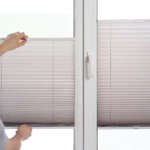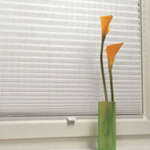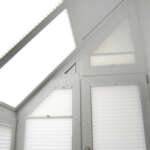Cordless top-down/bottom-up blinds are our speciality.
Our most popular blind layout can be lowered from the top of the window and raised from the bottom using movable rails. This combines easy and safe cordless operation of the blind to optimise your view with optimal control over light and privacy, as even a lightly raised blind from below will significantly change the angle of what can be seen from the outside, from below or front on.


Perfect for tilt & turn windows
As New Zealanders embrace the benefits of well-insulated homes. The popularity of energy efficient windows, such as double or triple glazed uPVC windows, is rapidly growing. Our tilt & turn window blinds are specifically designed to be installed directly to the glazing bead or frame sash of such windows and door, so the blind moves with the window or door and does not interfere with its operation. The same fabrics are available for fixed or standard windows to decorate the whole house.


100% German-made quality
Our blinds are manufactured exclusively in Germany, by the blind market leader Sensuna. High-tech cellular structures and protective coatings on the fabrics, together with specialised sturdy and light-weight Decomatic aluminium rails, ensure your blinds are of premium quality and ideally suited to New Zealand conditions.

CORDLESS VS. CORD-OPERATED BLINDS

We offer both cordless and cord-operated blinds. It is our priority to help you select blinds that are best suited to your windows and lifestyle. Cordless blinds are especially safe and convenient to operate, but as the blind depends on friction to be held up, there are size limitations to these types usually up to 1.2 or 1.5 metres wide. Cord-operated blinds are free hanging and can be made in much larger sizes, usually up to 2.2 metres wide. With our XL honeycomb blind, automated or manual up to 3.5m, all features that are particularly sought after in cordless blinds are also possible with cord-operated blinds: for example, the privacy offered by top-down/bottom-up operation, and lateral bracing to keep the blinds from swaying (see next section).
LATERAL BRACING KEEPS YOUR BLINDS FROM SWAYING

All our cordless blinds, and some free-hanging cord-operated blinds (as an optional feature), are laterally braced/anti-swing mechanism. This means there are tensioned cords running along the left and right edges of the blind (secured at the base of the blind), which guide the blind rails up and down. This method of bracing is essential for blinds that are mounted directly to operable windows, such as tilt & turn windows, as the blind then follows the movement of the window.
Lateral bracing is also particularly useful for blinds fitted in other locations where air movement may normally cause a blind rail to sway around. Enjoy a light breeze from an open window without the nuisance of a wildly swaying blind.
WATER AND STAIN-REPELLENT

Many of our fabrics are suitable for wet rooms such as laundries, bathrooms and kitchens. They are woven from special water-resistant fibres that remain stable even when wet, and are fast-drying. With an appropriate amount of ventilation, they are unlikely to be affected by mildew or mould.
FABRIC LAMINATION

Many of our fabrics have a reflective coat or lamination on the reverse side. By reflecting light, this enhances the blind’s heat protection capabilities. White lamination’s can reflect up to 86% of light while also darkening the room. Even translucent fabrics can have high reflection values when they are laminated with a pearl coat.

Heat protection Heat protection works in two directions. There are pleated blinds fabrics that help keep rooms cool on hot and sunny summer days, there are those that keep the warmth inside during colder days and there are those that do both. Heat protection on sunny days is provided by fabrics with a light reflecting lamination. The insulating effects of cellular or honeycomb blinds are useful when it comes to keeping the warmth inside. A combination of both is the all-round solution.

Public facilities Public or industrial facilities often have special demands towards any kind of textile room decor. In addition to practical demands such as suitability for display work stations, there are safety measures that need to be followed as well. In many buildings and facilities flame retardant materials are mandatory or at least preferable.

Flame retardant Public or industrial facilities often have special demands towards any kind of textile room decor. In addition to practical demands such as suitability for display work stations, there are safety measures that need to be followed as well. In many buildings and facilities flame retardant materials are mandatory or at least preferable.

Suitable for wet rooms There are some pleated blinds fabrics that are suitable for wet rooms such as laundry rooms, bathrooms and shower rooms or kitchens. They are woven from special fibers that are water resistant and remain stable even if they are wet. Pleated blinds made from those fabrics dry very fast. They are thus very unlikely to mildew or get moldy. However, an appropriate amount of ventilation is still necessary.

Suitable for display work stations Display work stations, whether they are situated at home or in the office need specific light protection. The room is not to be darkened completely; nevertheless any glare on the display is to be prevented, as it does not only hinders he work in progress but is also unhealthy for the eyes. The less translucent a fabric is, the higher are its anti-glare properties. All fabrics marked as suitable for display work stations can be used on workstations with south facing windows.

Laminated reverse side A reflecting coat or lamination on the reverse side enhances the heat protection capabilities of a pleated blind. White laminations reach reflection values of up to 86% but also darken the room. Translucent fabrics may be laminated with a pearl coat. Their reflection values depend strongly on the color of the fabric and lie anywhere between 27 and 70%.
SKY LIGHTS ODDLY SHAPED WINDOWS

